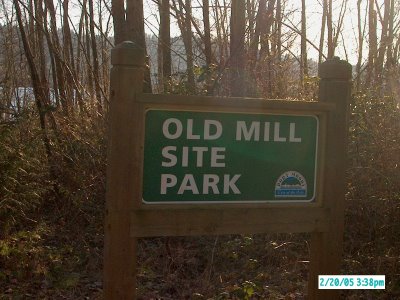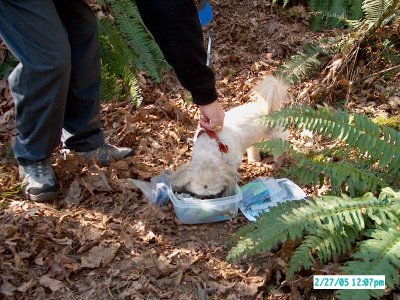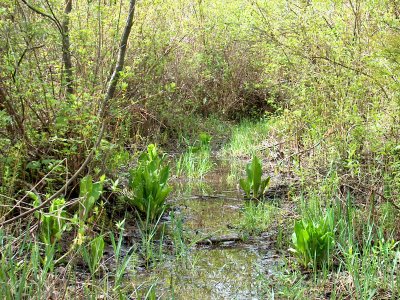
Annacis Island is located in the South Arm of the Fraser River. On the island there is a cache located at its most westerly tip; the cache is called “What’s the Point?” and it is hidden by Gorak.
The cache is located approx 1/3 of a mile from parking, but it’s the last 1000 feet that you have to be prepared for.
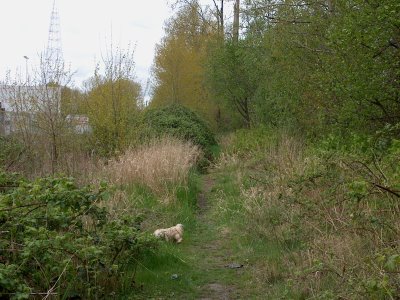
The walk starts off pleasant enough as you walk along an overgrown trail along the top of the dike. After approximately 200 feet the trail takes a slight bend as it moves away from the dike and now runs along an old skid road through the bush.
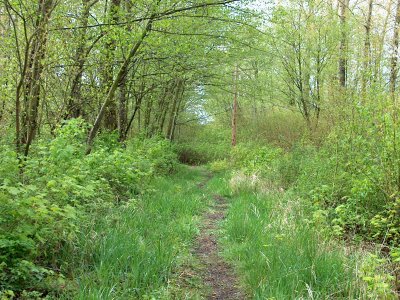
Again, so far so good; this part of the trail is a good gravel “road” easy to walk on.
Along this part is another cache called “Used Cassette Exchange” hidden originally by Team Muppet, now adopted by Queens Borrowers. Their cache is located next to the trail and is easily accessible.
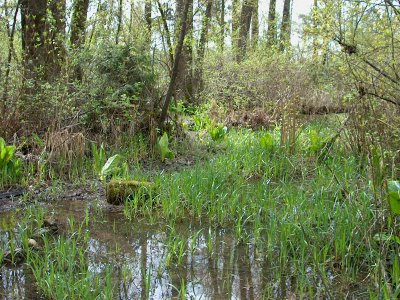
Continuing on, the trail takes another bend and suddenly comes to a dead end.
Well, at least you think it does: the trail carries on along the skid road but the road level is lower than before. Consequently rain water sits through here and the road is being reclaimed by nature in the form of a swamp.

Skunk cabbage grows large through this area and deep, slippery mud puddles force you to put on your big rubber boots to keep your feet dry. Hidden boards lying in the muck below the stagnant water are hoping you will step on them and take a slip-slide tumble onto your keyster, causing sure calamity for you and a definite photo-op for you companions.
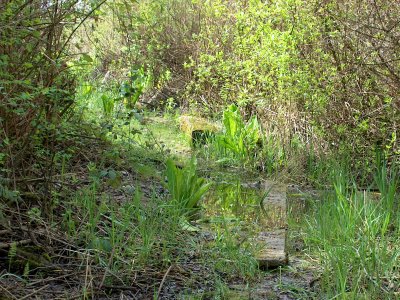
Once you get through the swamp the real fun begins: you have to cross the moat!
The moat is actually a side channel of water that cuts through the island. At best it is a 'boot sucking' mud crossing that threatens to suck your boots right off your feet leaving you hopping in the mud on one foot! And you know that never works….

At worst the moat is filled with 4 feet of water as the tide in the Fraser River rises and floods this end of the island. Across the moat some one has strung a large log chained at either end to large poles stuck in the ground. I don’t know about you, but log rolling was never my best subject in high school. It would be pretty tough to make it across the log without taking a bath.

We had timed our arrival at this cache to coincide with the lowest tide of the day:
HEY, we’re smart fellers. “I am so smart, S-M-R-T!”
Today we only had to risk having our boots sucked from our feet as we walked bravely across the channel with our gum boots making “shtuck shtuck” sounds as we took each stride.
Once past the moat the island appeared to be all tall grass, how ever that’s too good to be true. The tall grass hides more ankle deep mud that makes your boots go “shtick shtick” with each stride. Not quite as bad as the moat but definitely 'no running' through here.
Once past the grass you reach the end of the island and you are now walking on the break water consisting of large boulders. The cache is an easy find at this point and almost anticlimactic. The real challenge was just walking the last 1000 feet!


The view from here is beautiful as you are surrounded on both sides by the Fraser River with the marine traffic chugging by just a stone’s throw away. To the south is Delta with industry all along River Road and at the river’s edge; to the north is Richmond and large box warehouses along the river front. Way off to the north the North Shore Mountains in North Vancouver stand as testament to the forest that lays just beyond the city.
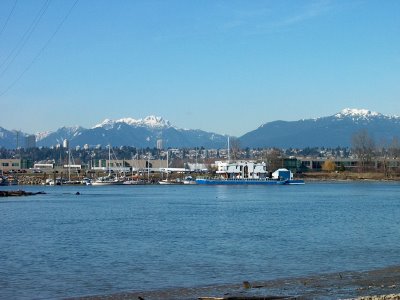
We took our time here as we signed the log book and sat on the rocks taking in the vista from this rare vantage point. Eventually we gathered up our gear and began the trek back through the 'shtick shtick' mud, through the 'shtuck shtuck' mud in the moat, and back along the swampy trail past the smelly skunk cabbage.
I’m told by other cachers that along the north shore of the island there is an old board walk along the water’s edge, reminiscent of by gone days when squatters may have lived there.
Back on dry land our boots were testament how muddy the walk to the cache had been, and how happy we were we had planned the visit to the cache just right.
As we walked back to the car we felt like fisherman just stepping off the river after a day of fresh water fly fishing. Our choice of foot gear was gangly and awkward on dry land, but necessary where we just came from.
This was a rewarding cache to find as the journey required foresight and the cache area was a treat to visit.







